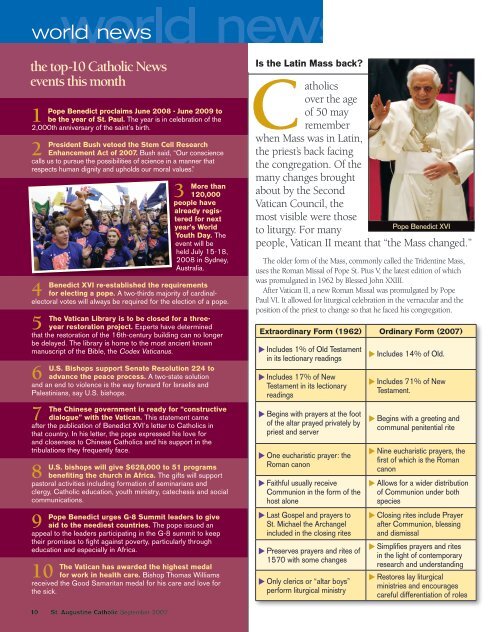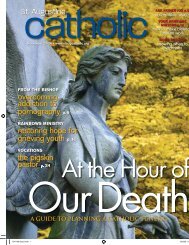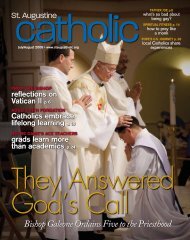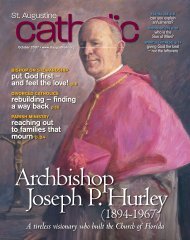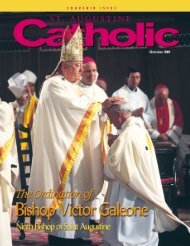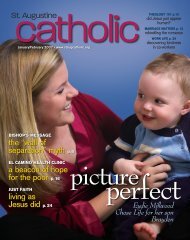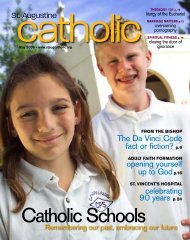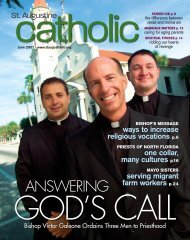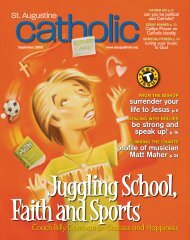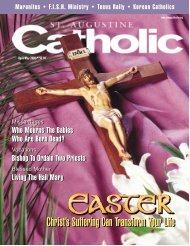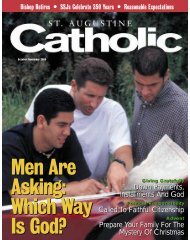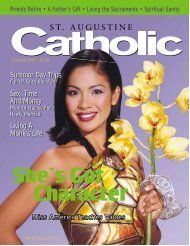September - St. Augustine Catholic
September - St. Augustine Catholic
September - St. Augustine Catholic
Create successful ePaper yourself
Turn your PDF publications into a flip-book with our unique Google optimized e-Paper software.
world news<br />
the top-10 <strong>Catholic</strong> News<br />
events this month<br />
1<br />
Pope Benedict proclaims June 2008 - June 2009 to<br />
be the year of <strong>St</strong>. Paul. The year is in celebration of the<br />
2,000th anniversary of the saint’s birth.<br />
2<br />
President Bush vetoed the <strong>St</strong>em Cell Research<br />
Enhancement Act of 2007. Bush said, “Our conscience<br />
calls us to pursue the possibilities of science in a manner that<br />
respects human dignity and upholds our moral values.”<br />
4<br />
3<br />
More than<br />
120,000<br />
people have<br />
already registered<br />
for next<br />
year’s World<br />
Youth Day. The<br />
event will be<br />
held July 15-18,<br />
2008 in Sydney,<br />
Australia.<br />
Benedict XVI re-established the requirements<br />
for electing a pope. A two-thirds majority of cardinalelectoral<br />
votes will always be required for the election of a pope.<br />
5<br />
The Vatican Library is to be closed for a threeyear<br />
restoration project. Experts have determined<br />
that the restoration of the 16th-century building can no longer<br />
be delayed. The library is home to the most ancient known<br />
manuscript of the Bible, the Codex Vaticanus.<br />
6<br />
U.S. Bishops support Senate Resolution 224 to<br />
advance the peace process. A two-state solution<br />
and an end to violence is the way forward for Israelis and<br />
Palestinians, say U.S. bishops.<br />
7<br />
The Chinese government is ready for “constructive<br />
dialogue” with the Vatican. This statement came<br />
after the publication of Benedict XVI’s letter to <strong>Catholic</strong>s in<br />
that country. In his letter, the pope expressed his love for<br />
and closeness to Chinese <strong>Catholic</strong>s and his support in the<br />
tribulations they frequently face.<br />
8<br />
U.S. bishops will give $628,000 to 51 programs<br />
benefiting the church in Africa. The gifts will support<br />
pastoral activities including formation of seminarians and<br />
clergy, <strong>Catholic</strong> education, youth ministry, catechesis and social<br />
communications.<br />
9<br />
Pope Benedict urges G-8 Summit leaders to give<br />
aid to the neediest countries. The pope issued an<br />
appeal to the leaders participating in the G-8 summit to keep<br />
their promises to fight against poverty, particularly through<br />
education and especially in Africa.<br />
10<br />
The Vatican has awarded the highest medal<br />
for work in health care. Bishop Thomas Williams<br />
received the Good Samaritan medal for his care and love for<br />
the sick.<br />
Is the Latin Mass back?<br />
<strong>Catholic</strong>s<br />
over the age<br />
of 50 may<br />
remember<br />
when Mass was in Latin,<br />
the priest’s back facing<br />
the congregation. Of the<br />
many changes brought<br />
about by the Second<br />
Vatican Council, the<br />
most visible were those<br />
Pope Benedict XVI<br />
to liturgy. For many<br />
people, Vatican II meant that “the Mass changed.”<br />
The older form of the Mass, commonly called the Tridentine Mass,<br />
uses the Roman Missal of Pope <strong>St</strong>. Pius V, the latest edition of which<br />
was promulgated in 1962 by Blessed John XXIII.<br />
After Vatican II, a new Roman Missal was promulgated by Pope<br />
Paul VI. It allowed for liturgical celebration in the vernacular and the<br />
position of the priest to change so that he faced his congregation.<br />
Extraordinary Form (1962) Ordinary Form (2007)<br />
Includes 1% of Old Testament<br />
in its lectionary readings<br />
Includes 17% of New<br />
Testament in its lectionary<br />
readings<br />
Begins with prayers at the foot<br />
of the altar prayed privately by<br />
priest and server<br />
One eucharistic prayer: the<br />
Roman canon<br />
Faithful usually receive<br />
Communion in the form of the<br />
host alone<br />
Last Gospel and prayers to<br />
<strong>St</strong>. Michael the Archangel<br />
included in the closing rites<br />
Preserves prayers and rites of<br />
1570 with some changes<br />
Only clerics or “altar boys”<br />
perform liturgical ministry<br />
Includes 14% of Old.<br />
Includes 71% of New<br />
Testament.<br />
Begins with a greeting and<br />
communal penitential rite<br />
Nine eucharistic prayers, the<br />
first of which is the Roman<br />
canon<br />
Allows for a wider distribution<br />
of Communion under both<br />
species<br />
Closing rites include Prayer<br />
after Communion, blessing<br />
and dismissal<br />
Simplifies prayers and rites<br />
in the light of contemporary<br />
research and understanding<br />
Restores lay liturgical<br />
ministries and encourages<br />
careful differentiation of roles<br />
10 <strong>St</strong>. <strong>Augustine</strong> <strong>Catholic</strong> <strong>September</strong> 2007


